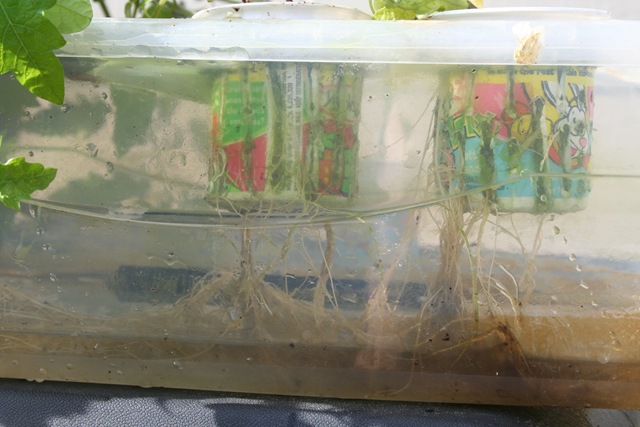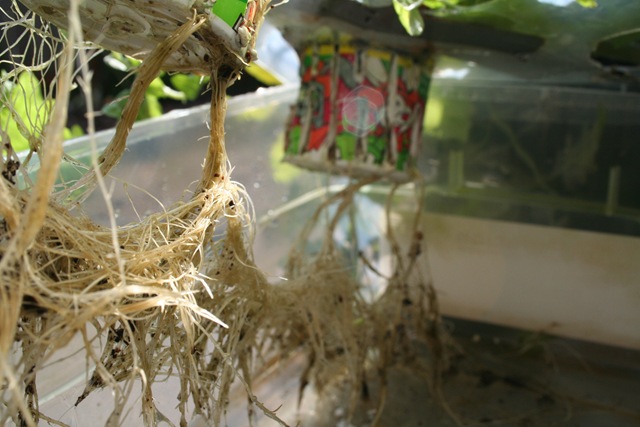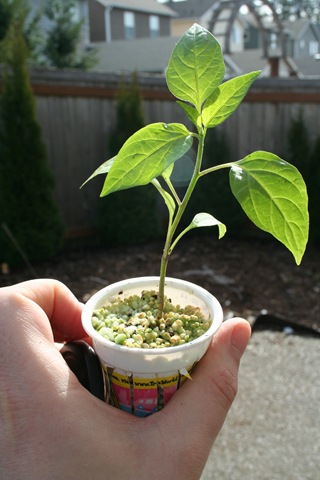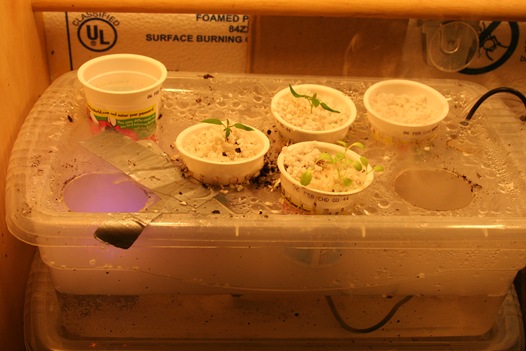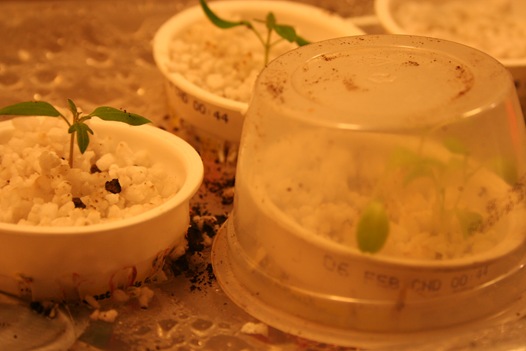Cheap fogger hydroponics final results
15.1 years ago aeroponics, cheap, hydroponics, peppers, tomato
In case you missed them here is the original post on the creation of this fogger hydroponic system, and the latest update (before this one).
The plants still are still looking pretty healthy with the exception of a little phosphorus deficiency, but the blame goes on me for that one. Been a little busy at work and have been neglecting the plants.
I decided to end this experiment since their roots were starting to get tangled and I want to use these plants for another project.
These roots are healthier than they look, some soil leached in when I put some of my pepper plants on top of the hydroponic box.
This pepper plant look really good, haven’t decided what to do with it yet. Maybe the victim volunteer for the next hydroponic experiment.
Tags: cheap, led, outdoor plants, pepper plants, vegetables
Cheap DIY fogger aeroponic system
15.2 years ago aeroponics, cheap, hydroponics, indoor growbox, indoor seed starting
In my post about basic the basics of hydroponics I mentioned the potential high cost of entry but with a little creativity this can be avoided. I went through this exercise and here is a pretty inexpensive way to try out hydroponics without having to spend hundreds on a prebuilt system. The solution I came up with cost me $1.00 to setup though I did have many of the items on hand, if I had to purchase everything cost would be in the $10-15 range.
Supplies
- Small shoebox sized plastic tub /w lid — (I purchased a clear generic one from Home Depot for $1.00)
- 2 inch hole saw and drill
- 6 — Empty Trix yogurt cups (can be any brand as long top is approx 2 in diameter)
- Duct tape (no one should be without this)
- Pond fogger – single disc (can be found on eBay for less than $10, I had one from humidifier)
- Perlite
- Water (tap water is fine, fancy bottles work as well)
Assembly
From looking at the supplies this might be able to guess the construction steps, but I will list them out anyway.
- Take lid and add drill six 2-inch holes using hole saw. If the tub is not made of rubbery material be sure to take your time to slowly create the holes to prevent cracking/shattering. You can also do this with a utility knife but for non-rubber lids I highly suggest against it if you like your fingers.
- Test fit your cups and ensure they fit snuggly, if they do not quite fit you can use some sandpaper to expand the holes slightly
- Remove cups and cut (utility knife) or burn (soldering iron) 1/4 in lines in a pattern similar to the
 figure to the right to ensure extra support and prevent the medium (perlite) from falling through. WARNING: Burning plastic emits toxic fumes and should be done (if at all in a well ventilated area) Knifes are sharp and can cut fingers so if you not careful. I would recommend buying 2 inch hydroponic net pots which can be purchased for about $0.25 each online, which I would have done if I wasn’t so impatient.
figure to the right to ensure extra support and prevent the medium (perlite) from falling through. WARNING: Burning plastic emits toxic fumes and should be done (if at all in a well ventilated area) Knifes are sharp and can cut fingers so if you not careful. I would recommend buying 2 inch hydroponic net pots which can be purchased for about $0.25 each online, which I would have done if I wasn’t so impatient. - Given that nutrients+water+light=algae, be sure that your box is as light tight as possible. If you container is not clear like mine you should be in good shape, otherwise cover your box with duct tape or spray paint the box using plastic adhering paint. I would recommend keeping a small vertical line exposed so you can get a quick look at water condition and level without having to disturbing the plants.
- Fill cups with perlite 4/5 full (some expansion may occur)
- Pour water into cups until reservoir is full
- Dump water out water
- Repeat steps 4-6 until water appears clear
- Cut small hole in the corner of the lid and feed power line to fogger through
- Put fogger in tub and fill with water until it is about 1/2 inch above fogger
- Replace lid and plug in fogger and enjoy the mysterious fog
What can I grow with this?
The short answer is anything. Self regulation wicking properties of perlite it should keep most plants happy for some time. The major limitation you may see is some types of plants will outgrow this setup and will require transplant outside in soil or in a larger hydroponic setup (coming soon). Though with careful selection of plants and frequent harvesting you can grow many plants to maturity in this small system. It did not occur to me until after I completed the project but the size and spacing is pretty close to that of an AeroGarden so plants like greens, herbs, strawberries, cherry tomatoes, peppers would do well in this system. For starting plants you can simply drop a few seeds, cover with some perlite and a clear plastic container (I used empty applesauce cups, but bottom of water bottles also would work well) You may also add seedlings by carefully placing in them in the damp perlite.
What about nutrients?
Keeping the project cheap I opted to use some balanced liquid plant fertilizer I use for my seedling/indoor plants. I mixed it at the recommendation it stated for indoor watering (2 pumps per gallon) I noticed it did not contain any Magnesium I also added a half a teaspoon of Epsom salt. After a couple weeks empty contents and replace with water let run for about an hour to allow sediments to clear up and then empty contents. This is good for your plants but also can help keep the disc on your fogger clean. Refill with water and nutrient mix and repeat. This will work for most plants in vegetative state of growth though if you want your plants to move to a flowering state (peppers, tomatoes, etc) I would recommend purchasing specific hydroponic solution for flowering plants.
For a very small investment you can have your own hydroponic system and experience the benefits of growing without soil.
Tags: cheap, garden seeds, herb garden, outdoor plants, pepper plants, strawberry plants, tomato plants, vegetables
Hydroponics 101 “ Introduction to Hydroponics
15.2 years ago aeroponics, hydroponics, indoor seed starting, water
By definition hydroponics is a technique of growing plants (without soil) with water containing dissolved nutrients. No soil is used but in most cases a growing medium is used to support the plant’s root system. A few examples of popular mediums are perlite, vermiculite, Rockwool, coconut coir, clay pellets, peat moss, sand, and even small pebbles. The basic idea behind the medium is to allow water to flow but also allow oxygen to be available to the roots. Even if you are not planning on growing hydroponically, I would definitely recommend learning some about the subject since many of the concepts can help you get a different perspective to have a better understanding about plants needs in various states of growth even with conventional soil growing. If you really think about it if you have ever added water soluble plant food while watering your indoors plants, you technically have already done some hydroponic gardening.
Advantages:
The primary advantage if hydroponics is the increased speed of growth in you plants. This is possible because you are making life really easy for your plants, they just relax and just keep getting bigger. Even with a small root system they are getting exactly what they need to thrive thus spending more energy upstairs instead of expanding their root system. This is possible by careful control of nutrients in the water solution which the plant is completely dependent since the growing medium does not provide any nutritional support. Another benefit is automation, though some work is required to monitor nutrient levels and pH of the solution once everything is setup you can walk away knowing that your plants will be happy. Given the in most cases the systems are basically closed very little water is lost to evaporation so that means less wasted water (and less times you have to add water)
Disadvantages:
To create a large scale setup, there can be a significant cost to get started in hydroponics. Purchasing water/air pumps various nutrient solutions during various growth stages, monitoring equipment, pH balancing, etc. No worries though, there is a cheap solution to all of this which is my current project which I will write on shortly. When automation fails, a simple pump failure can kill off your plants in hours depending in your medium since they plants require short and frequent watering since they have no way of maintaining the moisture over a long period of time.
How it works:
The great thing about hydroponics is essentially anything that holds water can be used to create a hydroponic system. Even commercial solutions use your regular old Rubbermaid storage totes and 5 gallon buckets. The uniqueness begins with the method in which you get the solution to your plants which I will explain some of the popular methods in detail below:
- Wicking — This is one of the simplest and cheapest methods of hydroponics. The basic concept is you take a material such as cotton (shredded sock/T-shirt) and surround it with growing medium and place one end in the nutrient solution. This is where the name implies, the solution is wicked to the roots of the plant. You can make this even simpler by using a medium that has some wicking properties itself (perlite/vermiculite are good examples) and suspend the medium directly in the solution. Mediums such as peat moss, Rockwool, and coconut coir should not be placed directly in the solution since they may absorb too much solution and suffocate the plant.
- Bubbler — This is also a simple and inexpensive solution where you suspend the roots directly in the nutrient solution and by leveraging a powerful air pump and air stone you create enough oxygen around the roots to prevent suffocation. This can also work as flavor of aeroponics (which I will explain more below) where the force of the rising bubbles create a light spray to keep the roots moist which are suspended in air. One benefit of this method is limited points of failure air pumps are normally pretty reliable and even if you neglect keeping your solution up the bubbling can create enough moisture to keep your plant alive for quite awhile.
- Ebb and Flow — A simpler way of thinking about this is flood and drain, using a water pump at a specified interval you flood the growing area with nutrient solution allowing it to slowly drain back into the reservoir. You then repeat this process keeping the roots/medium at the desired wetness. This method is a little more expensive than the previous methods since it requires a pump and timer that can turn off/on several times a day at short intervals. Just to give you an idea how to build a system like this, find a Rubbermaid tub with a pretty deep lid. Flip the lid over and place a small hole in the bottom (idea it will drain but slower than pump can fill) add some plants with medium, hook up a timer and you have a system. A major advantage to this method is that it gives you more control over the watering which can be very important especially if you are growing plants that are accustomed to slight drying out periods.
- Drip — This method uses a timer (slow constant drip is also an option) and a water pump to provide nutrient solution to all of your plants using rubber tubing. This does have an advantage over Ebb Flow were you can control specific watering needs of plants at different stage and the ability to spread out your plants with a little extra tubing.
- Aeroponics — Aeroponics is the process of growing plants in an air or mist environment without the use of soil or an aggregate medium. Now there are some schools of thought one what exactly is considered a “mist” which separates aeroponics from “pure aeroponics” but for this discussion we will define it as directly watering roots just hanging in the air. If you have heard of the AeroGarden
this is a commercialized version of this technique, so this can definitely be an easy means of entry into aeroponics. There are two typical ways to get nutrients to the exposed roots: fog and spray nozzles both of which providing a fine mist to the tender roots. Both of these methods due have some drawbacks though. Ultrasonic foggers can accumulate sediments from the nutrient solution on their discs but can be periodically cleaned and occasionally need replacement of their ceramic/Teflon discs. Nussle on the other hand can get clogged due to the same sediments so though these methods are close to “Set it and forget it” you do need to check on them periodically for maintenance. Though these techniques sound really complicated and expensive they really are not too bad. You can use Pond Foggers which run $10-100+ depending on the number of discs they hold which directly to the volume of fog they will produce. If you are doing a small experimental setup a one disc is a good place to start. If you do go the larger setup route I definitely would advise spending a little extra for Teflon coded discs since they will hold up considerable better to the nutrient solution. As for sprayers most of the materials for this can be found in the sprinkler aisle of you local Home Depot. You can also create your own by drilling some small holes into a sealed (one open end for water input) PVC tubing, though cleaning a setup like this could be troublesome.
Hydroponics is obviously much different than conventional soil growing, but it definitely can be fun and rewarding to grow effectively in an unconventional way.
Tags: cheap, led, outdoor plants
Broto Domestic Greenhouse grows plants through aeroponics
15.4 years ago aeroponics, hydroponics, indoor growbox
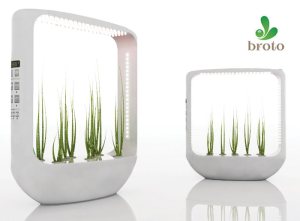
If you want something that is a little more aesthetically pleasing than the $20 PC Grow box and don’t have the counter space for an AeroGarden then the Broto Domestic Greenhouse might be the right option for you. Information such as price and if it will actually be commercially available seem to be missing, but seems to be a completely self contained aeroponics solution and given the use of LEDs for lighting I would imagine it would be a fairly low power consumer.
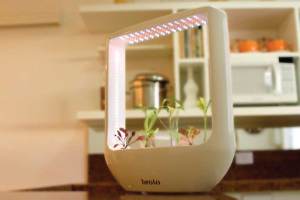
Tags: cheap, growbox, led, outdoor plants, vegetables
